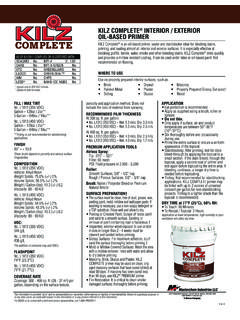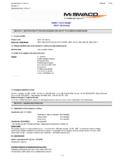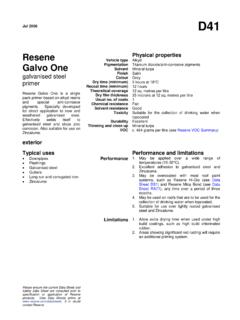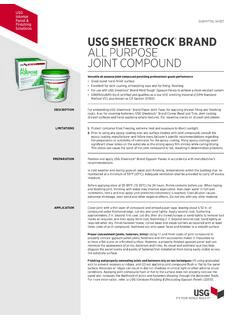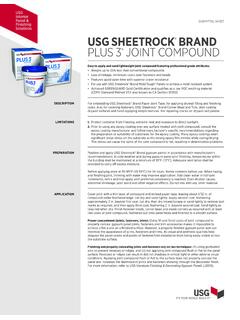Transcription of SAFETY DATA SHEET - KILZ
1 GHS Pictograms: SAFETY data SHEET SECTION 1 : IDENTIFICATIONP roduct Name:KILZ Original Interior/Exterior Primer (350 VOC)Product Code:1009 SDS Manufacturer Number:1009 Manufacturer Name:Masterchem Industries LLCA ddress:3135 Old Highway MImperial, MO 63052-2834 General Phone Number:(636) 942-2510 General Fax Number:(636) 942-3663 Customer Service PhoneNumber:(800) 325-3552 CHEMTREC:For emergencies in the US, call CHEMTREC: 800-424-9300 Canutec:In Canada, call CANUTEC: (613) 996-6666 (call collect)SDS Creation Date:February 15, 2019 SDS Revision Date:February 15, 2019 SECTION 2 : HAZARD(S) IDENTIFICATIONS ignal Class:Flammable Liquid, Category Hazard, Category Irritant, Category Irritant, Category Target Organ Toxicity, Single Exposure, Category Inhalation Toxicity, Category 4 Hazard Statements:Flammable liquid and vaporMay be fatal if swallowed and enters serious eye if cause respiratory irritation, drowsiness or Statements:DO NOT use this product unless you can achieve cross-ventilation by opening windows and doors duringapplication and drying or use the product not spray on an open flame or other ignition all flames and pilot lights and turn off stoves, heaters, electric motors, high intensity lightsand other sources of ignition during use and until all vapors are case of fire.
2 Use dry chemical, carbon dioxide to extinguish small fires. Use water for large protective clothing, gloves, eye, and face not breathe vapors or spray mist. Do not eat, drink or smoke when using this hands thoroughly after off contaminated clothing and wash it before container tightly locked up in a cool, well-ventilated of unused contents, container, and other contaminated wastes in accordance with local, state,federal, and provincial regulations. If in eyes: Rinse cautiously with water for several minutes and remove contacts if present and easy todo. Continue rinsing and get medical attention if eye irritation persists. If on skin or hair: Wash with plenty of soap and water. If skin irritation or rash occurs, get medicalattention.
3 If inhaled: Leave the area if you experience headaches, drowsiness or dizziness to obtain fresh air andkeep at rest in a position comfortable for breathing. If difficulty continues, get medical attentionimmediately. If swallowed: Do not induce vomiting and get medical attention Overview:DANGER! Flammable. Harmful if swallowed. Aspiration may occur during swallowing or vomiting,resulting in lung damage. Harmful if inhaled. Inhalation of vapors may cause drowsiness anddizziness. of Exposure:Eyes. Skin. Inhalation. Health Effects: Eye:Causes severe eye irritation and possible injury. Skin:Causes skin irritation. Inhalation:Harmful if inhaled. Inhalation of vapors may cause drowsiness and dizziness. Prolonged or excessiveinhalation may cause respiratory tract irritation.
4 Ingestion:Harmful if swallowed. Ingestion can cause nausea, vomiting, diarrhea and gastrointestinal of petroleum distillates into the lungs can cause severe chemical pneumonitis that can Health Effects:Prolonged or repeated contact can result in defatting and drying of the skin, which may result in skinirritation and dermatitis (rash).Repeated or prolonged inhalation may cause toxic : KILZ Original Interior/Exterior Primer (350 VOC) | Manufacturer: Masterchem Industries LLC | Revison:2/15/19, Version:0 Page 1 of 6 Signs/Symptoms:Overexposure can cause headaches, dizziness, nausea, and Organs:Eyes. Skin. Respiratory system. Digestive system. Central nervous system. of Pre-ExistingConditions:May aggravate pre-existing respiratory disorders, allergy, eczema, or skin 3 : COMPOSITION/INFORMATION ON INGREDIENTSC hemical NameCAS#Ingredient Percent EC Num.
5 Calcium carbonate (limestone)1317-65-3 10 - 30 by weight Rutile1317-80-2 5 - 10 by weight Distillates (petroleum), hydrotreated light; Kerosine - unspecified64742-47-8 5 - 10 by weight Mineral spirits8052-41-3 1 - 5 by weight Nepheline Syenite37244-96-5 5 - 10 by weight Silicate, mica12001-26-2 10 - 30 by weight Talc, Magnesium silicate hydrate14807-96-6 1 - 5 by weight Titanium dioxide13463-67-7 5 - 10 by weight VM&P Naphtha/Aliphatic Hydrocarbon8032-32-4 5 - 10 by weight SECTION 4 : FIRST AID MEASURESEye Contact:Immediately flush eyes with plenty of water for at least 15 to 20 minutes. Ensure adequate flushing ofthe eyes by separating the eyelids with fingers. Remove contacts if present and easy to do.
6 Continuerinsing. Get medical attention, if irritation or symptoms of overexposure Contact:Immediately wash skin with soap and plenty of water. Get medical attention if irritation develops or :If inhaled, remove to fresh air. If not breathing, give artificial respiration or give oxygen by trainedpersonnel. Seek immediate medical :If swallowed, do NOT induce vomiting. Call a physician or poison control center immediately. Never giveanything by mouth to an unconscious First Aid:Due to possible aspiration into the lungs, DO NOT induce vomiting if ingested. Provide a glass of waterto dilute the material in the stomach. If vomiting occurs naturally, have the person lean forward toreduce the risk of 5 : FIRE FIGHTING MEASURESF lammable Properties:Flammable Point:74 F (23 C)Flash Point Ignition Temperature:Not Flammable/Explosive by volumeUpper Flammable/Explosive by volumeFire Fighting Instructions:Flammable.
7 Cool fire-exposed containers using water Media:Use dry chemical, carbon dioxide to extinguish small fires. Use water for large Equipment:As in any fire, wear Self-Contained Breathing Apparatus (SCBA), MSHA/NIOSH (approved or equivalent)and full protective Fire Hazards:Flammable liquid. Vapors can form an ignitable mixture with air. Vapors can flow along surfaces to adistant ignition source and flash Ratings:NFPA Health:1 NFPA Flammability:3 NFPA Reactivity:1 SECTION 6 : ACCIDENTAL RELEASE MEASURESP ersonal Precautions:Evacuate area and keep unnecessary and unprotected personnel from entering the spill area. Useproper personal protective equipment as listed in Section Precautions:Avoid runoff into storm sewers, ditches, and : KILZ Original Interior/Exterior Primer (350 VOC) | Manufacturer: Masterchem Industries LLC | Revison:2/15/19, Version:0 Page 2 of 6 PPE Pictograms:Methods for containment:Contain spills with an inert absorbent material such as soil or sand.
8 Prevent from spreading bycovering, diking or other means. Provide ventilation. Eliminate all ignition sources including thosebeyond the immediate spill area if safe to do for cleanup:Clean up spills immediately observing precautions in the protective equipment section. Collect spill witha non-sparking tool. Place into a suitable container for disposal. Take precautionary measures againststatic discharges. After removal, flush spill area with soap and water to remove trace 7 : HANDLING and STORAGEH andling:DO NOT use this product unless you can achieve cross-ventilation by opening windows and doors duringapplication and drying or use the product outdoors. Avoid breathing vapor and contact with eyes, skinand clothing.
9 Material will accumulate static charges which may cause an electrical spark (ignitionsource). Use proper grounding :Store in a cool, dry, well ventilated area away from sources of heat, combustible materials, andincompatible substances. Keep container tightly closed when not in Practices:To reduce potential for static discharge, bond and ground containers when transferring Handling Procedures:Do not reuse containers without proper cleaning or Practices:Wash thoroughly after handling. Avoid contact with eyes and skin. Avoid inhaling vapor or 8: EXPOSURE CONTROLS, PERSONAL PROTECTIONE ngineering Controls:Use appropriate engineering control such as process enclosures, local exhaust ventilation, or otherengineering controls to control airborne levels below recommended exposure limits.
10 Good generalventilation should be sufficient to control airborne levels. Where such systems are not effective wearsuitable personal protective equipment, which performs satisfactorily and meets OSHA or otherrecognized standards. Consult with local procedures for selection, training, inspection and maintenanceof the personal protective Protection:Wear appropriate protective glasses or splash goggles as described by 29 CFR , OSHA eyeand face protection regulation, or the European standard EN Protection Description:Chemical-resistant gloves and chemical goggles, face-shield and synthetic apron or coveralls should beused to prevent contact with eyes, skin or Protection:A NIOSH approved air-purifying respirator with an organic vapor cartridge or canister may bepermissible under certain circumstances where airborne concentrations are expected to exceedexposure limits.
